All around the world, there are traditions for welcoming and celebrating the arrival of Spring. Spring represents new life, renewed hope, and fresh starts. This is reflected in the number of religious and cultural festivals which take place during the season, including Mardi Gras, Easter, Passover, the Songkran Water Festival, Holi, Nowruz, St David’s Day, St Patrick’s Day, May Day, all of which provide lots of opportunities for interesting research.
Read on to find out about a range of practical activities centred around all things Spring which you may like to try.
Food and Farming, Growing and Gardening
Children are generally very enthusiastic about the prospect of cooking and eating and it can be a terrific way to introduce them to key skills and encourage them to try new foods.
Health and safety aspects are key when food is involved. Concepts such as hygiene, use of tools and equipment, safety around hot temperatures and so on, need to be explained, taught, and reinforced. Obviously, food allergies, intolerances, dietary choices, and cultural/religious observances should be taken into consideration when planning food-related activities. There are now many alternatives which can be substituted for any “problem” ingredients so this should help to ensure that all children can feel included. If you are intending to carry out food preparations in a class setting, it is much easier and more manageable (both in terms of health and safety and quantities of ingredients), to plan this as a group activity.

Spring Soup Recipe
Tools & Equipment
- Peelers
- Knives
- Graters
- Chopping Boards
- Wooden Spoons
- Large Saucepan
- Small Bowls to serve
- Spoons
If a spiraliser is available, children would enjoy using this to prepare the carrots (they could use clean kitchen scissors to cut the ribbons into manageable lengths).
Ingredients (suggested but could be adapted as required)
- Butter/Oil
- Vegetable Stock
- Potatoes (mini – leave skins on)
- Selection of vegetables such as Spring Onions, Peas, Carrots, Edamame, Sweetcorn (regular or baby corn cobs), Okra
- Chives, Parsley, Lemon Zest and Juice
- White Pepper and Salt
- Yoghurt
- Cheese (pecorino)
How to:
-
- Peel and chop vegetables, as necessary.
- Heat the butter or oil in a large pan and add onions, carrots, potatoes and cook for a few minutes.
- Add the stock and simmer for around 10 minutes.
- Add all other vegetables and herbs and continue to simmer until the potatoes are cooked.
- Serve with a small dollop of yoghurt and a large pinch of grated cheese.
Pancake Party
Children and/or adults could design and make sweet and savoury pancakes with a variety of fillings. These could be tasted and given a rating based on various categories such as aroma, flavour, texture etc. Which is the favourite pancake of your family/class?
Chocolate Nests
A sweet treat which looks as lovely as it tastes. These edible nests can be created using simple and easily available ingredients. They can be made in a variety of sizes and make lovely gifts.

Ingredients
- Chocolate
- Shredded Wheat
- 3 Mini Eggs
How to:
- Melt the chocolate in the microwave – this can be an easier and safer option rather than on the stovetop.
- Break up the shredded wheat to create twigs, then mix into the melted chocolate.
- Spoon the mixture into paper cases if you have them, otherwise, they can be heaped and flattened slightly on a surface lined with parchment.
- Press mini eggs into the middle of the nest and leave to cool and set.
Eggshell Hairstyles
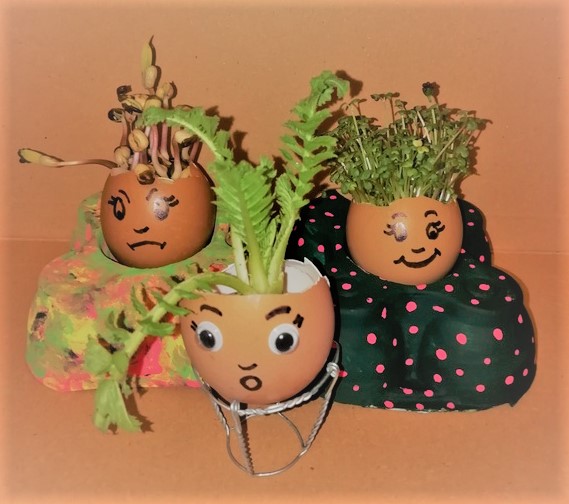
- Soak your choice of seeds in water overnight and then rinse.
- Wash fresh eggshells in hot, soapy water and rinse well.
- Pack the insides with cotton wool and dampen them.
- Place a layer of seeds onto the cotton wool and ensure it stays damp by misting it with water each day.
- Place the eggshell planters in a warm, sunny position and check in on them (mini diaries could be used to record progress).
Be aware of allergies when choosing things to plant. Cress, mustard seeds, and mung beans work well – you could even try regenerating the leaves on a carrot top. The seeds planted do not necessarily need to result in edible seedlings, for example, you could plant herb seeds ready to transplant when ready. The eggshell is easy enough to break open to do this without damaging the plants.
The eggshells can be decorated with a face drawn on it, and the addition of “googly eyes” can be fun. The eggshells can be housed in the empty egg box which can also be decorated. If eggshells are not available or appropriate, other items could be substituted e.g. dented Ping-Pong balls or mini yoghurt pots.
Farm Visits
Check whether any local/city farms have open days especially if they offer opportunities to see new-born lambs. This can be an amazing and enriching experience for everyone and can provide great inspiration for art and writing activities.
Art and Craft
One of the most uplifting signs of spring is the arrival of blossoms on trees. In Japan, cherry blossoms are called “Sakura” and during their short burst of beauty, lasting around two weeks, people enjoy partying with friends and family beneath the branches – a custom known as “Hanami” which translates as “watching blossoms” or “flower viewing.” The tradition is also enjoyed during the romantic atmosphere at night and is then known as “Yozakura.”
Cherry Blossom
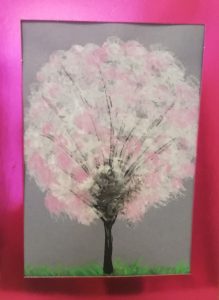
Painted representations of the cherry blossoms can be created using a variety of techniques, suitable for a range of ages and experiences.
A handprint in a darker colour can form the trunk and branches of a tree, and fingerprints in whites and pinks can serve as blossom petals. The tree structure can also be created using a drip and drizzle technique, straw blown, or via a paint brush. The blossoms can be stippled using brushes. Ready mixed colours could be provided, or children could explore mixing their own by matching with photographs. Some children may not enjoy the sensation of putting their hands/fingers into paint, so brushes or rubber-tipped colour shaping tools could be available for them to choose.
A 3-D version could be created using an interesting twig or a handmade wire armature, weighted down with clay or plasticene, or fixed into a small section of wood. This wire framework could be wrapped in brown crepe paper to simulate the effect of bark. Crumpled white tissue paper can be glued on to represent the blossoms and stippled with shades of pink paint to create depth of colour.
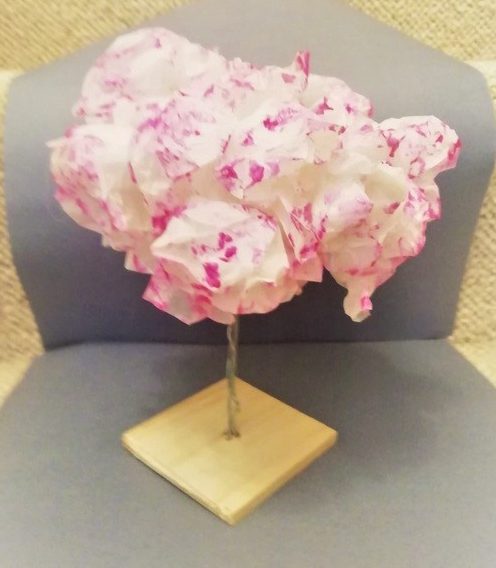
The 2-D and 3-D versions could be embellished with beads, sequins or touches of metallic paint if wished. An “orchard” of cherry trees would make a fantastic classroom display.
Spring Hats
Children could design and make spring hats for themselves or teddies. This could be undertaken using an existing hat and crafting a decorative hoop to drop onto the rim or by making a simple hat from scratch. Children could use pre-cut shapes or make items from available materials. The hats could be worn in a parade, or the teddies could be grouped to form a millinery display.
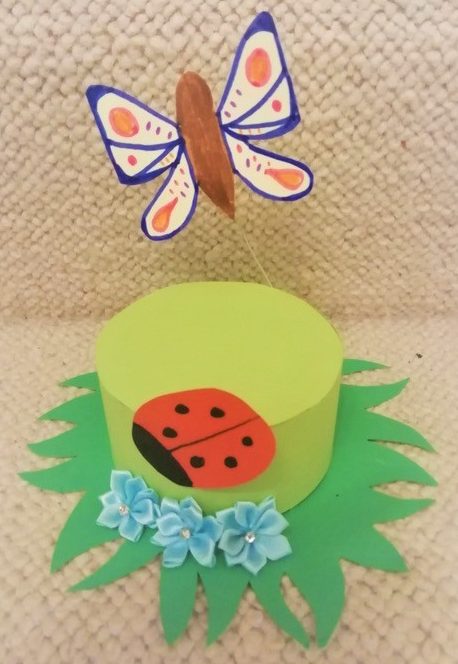
Pop-Up Cards
There is a wide variety of techniques which can be used to create a range of pop-up cards and there is a wealth of videos and instructions online to help learn how to do this. The examples shown here use a hinge, a beak, and a folded spring to create the effects.
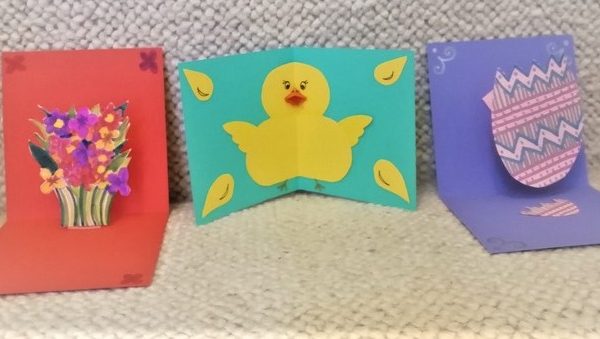
Thumbprint Creatures
Features can be added to a thumbprint to transform them into creatures. By including speech bubbles, a cute conversation can be illustrated. Using Spring jokes could make great greetings cards or be compiled into a book. Using a regular felt pen to colour the thumb is a good option as it washes off more easily than printing pad ink.
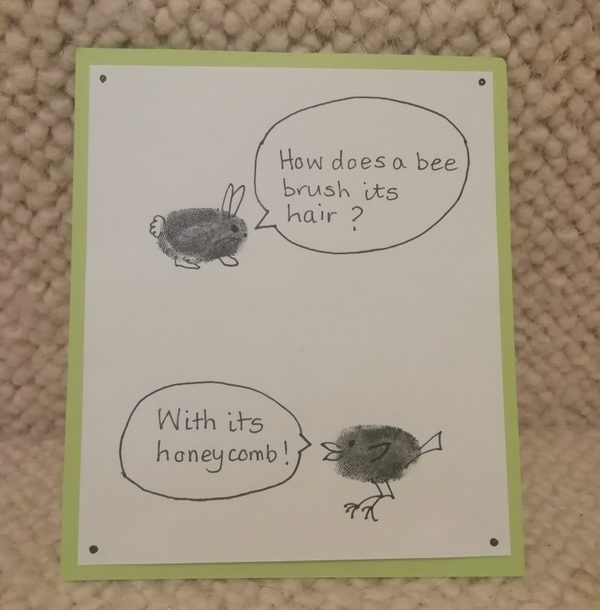
Design Technology
Years ago, the school I was working at used to run a design technology competition in the run-up to Easter. The brief was to build a vehicle to transport an egg safely down the steeply sloping playground. The vehicles were judged on a range of categories from appearance to distance travelled, to their ability to arrive with the cargo undamaged. It was a hugely popular activity with the children but these days, it would be acknowledged that this could be regarded as a waste of food and not vegan-friendly. A feasible alternative would be to use a balloon filled with water and knotted at the end or a ping-pong ball as a substitute for the egg, although it would be trickier to judge the “safety” aspect of the task.
Book Recommendations
- Everything Spring (Picture the Seasons) Nat Geo Kids – Jill Esbaum
- A Poem for Every Spring Day – Allie Esiri
- Sakura’s Cherry Blossoms – Robert Paul Weston, Misa Saburi
With many thanks to Jayne Gilbert for sharing her ideas in this blog.
My name is Jayne and I have been a teacher for around 34 years. 23 of these were spent working as a class teacher in two primary schools in South-East London where I also had the additional responsibility for Literacy and/or Art. This wasn’t really unexpected as my mum was also a teacher and for as long as I can remember, she fostered in me a love of books and reading, art and craft. Since leaving class teaching, I have worked in an office, as a labourer on a construction site, and back in an office for a short while. Recently, I have rediscovered my love of writing and this has been put to good use volunteering for the e-commerce department of my local hospice shop, creating descriptions for advertising items.
I hope you enjoy reading about my ideas and trying out the activity suggestions!


